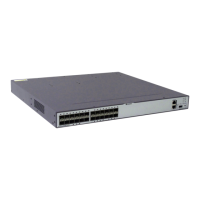Data Preparation
To apply filters to received routes, you need the following data.
No. Data
1 Name of the IP prefix list
2 Name of the ACL
3 Name of the Route-Policy and node number
10.5.2 Filtering Routes Received by RIP
By applying filters, you can control the receiving of RIP routes.
Context
Do as follows on the switch that runs RIP:
Procedure
Step 1 Run:
system-view
The system view is displayed.
Step 2 Run:
rip [ process-id ] [ vpn-instance vpn-instance-name ]
Step 3 Run either of the following commands as required:
l filter-policy { acl-number | acl-name acl-name } import [ interface-type interface-
number ]
l filter-policy gateway ip-prefix-name import
l filter-policy ip-prefix ip-prefix-name [ gateway ip-prefix-name ] import [ interface-type
interface-number ]
The filtering policy is configured for routes received by RIP.
The filter-policy is configured in the RIP process. If routes are filtered based on an interface,
you can configure only one route-policy based on the interface at a time. If no interface is
specified, the system considers the configured route-policy as the global route-policy, and you
can configure only one route-policy at a time. If the route-policy is configured repeatedly, the
new route-policy will replace the old route-policy.
----End
10.5.3 Filtering Routes Received by OSPF
By applying filters, you can control the receiving of OSPF routes.
S6700 Series Ethernet Switches
Configuration Guide - IP Routing 10 Routing Policy Configuration
Issue 01 (2012-03-15) Huawei Proprietary and Confidential
Copyright © Huawei Technologies Co., Ltd.
603

